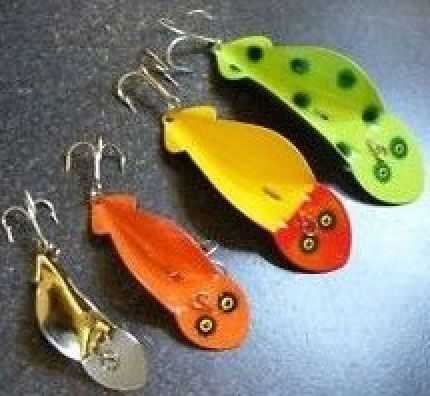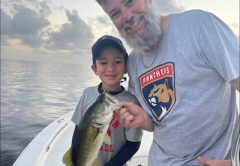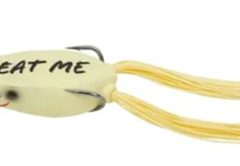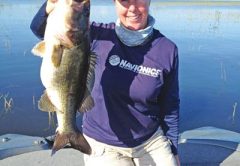Ask a fisherman who was the greatest fisherman of all time and they will probably say Roland Martin, Bill Dance or the incredible Kevin Van Dam. Others might include lesser known fishing celebrities local to their areas, but few would mention Elwood “Buck” Perry, from Hickory, North Carolina.
Born in 1915, Buck never won a fishing tournament (because he never fished one); never had a TV show or radio program, or even a newspaper column; but he had the keen, analytical mind of a fisherman trained in scientific principles who constantly asked the question “why” and then sought out the answer.
Learning to fish at an early age with his father, Robert Perry, who was an avid fisherman himself, the two became inseparable fishing companions. In March of 1928, Robert took his son to a large Carolina mountain reservoir that was loaded with fish. By today’s standards it was a virgin lake in every respect with no pollution, no other fishermen on the lake and the idea of water-skiing hadn’t been invented yet. But the fish weren’t biting and little Elwood startled his father when he said “You know dad, the deep water is the home of the fish.” Robert just rolled his eyes at his son’s comment and continued casting inches away from the shoreline.
Several days later on the same lake, again with no fish, he startled his dad again with “Not only is the deep water the home of the fish, but they move on paths toward the shallow water. How far they come and how long they stay is controlled by the weather and water conditions. Dad, we’re not only fishing wrong, we’re fishing in the wrong place.”
This time his dad did more than roll his eyes. “If you don’t stop making those crazy statements, I’m going to throw you in the lake.”
Later, Elwood would explain that he had heard the opinions of the so-called “fishing experts” and that no two were ever alike. Since there were so many different ideas floating around, none of which would stand up to scientific scrutiny, it was likely none of them were correct.
He had been looking into the water for a long time. Some days he would see scads of fish swimming around, but most of the time he saw very few or none at all. Since the fish were not very often in the shallow water, and they could not swim up into the woods and hide behind a tree, they obviously had to be someplace else. That place had to be deep water.
He also observed that when he did see fish, they would always be in the same shallow areas, yet other areas were always barren. He concluded they must be following a path.
It would be 50 years later that I learned who this man was and his incredible insights into fishing.
In the early 1970’s I opened my first fishing tackle store in Ohio. It was a modest operation, fueled by my passion for fishing, not my acumen for running a business. Bass fishing tournaments were just beginning to catch on and technology was rapidly catching up with the fishermen’s thirst for knowledge.
Like most fishermen in those days, I fished the shallow waters with top-water lures, spinnerbaits, crankbaits, jigs and worms. On some occasions, bass would seemingly be everywhere, easy to catch, while other days, fishing the same lures and the same areas, I couldn’t buy a fish.
One day, two young fishermen stopped by the store and it didn’t take me long to realize that these two fishermen, Don Dickson and Mike Smith knew more about finding and catching fish than I’d ever thought possible. They were from Hickory, North Carolina and they worked for a gentleman named Buck Perry.
Not only could they talk a good story, but they took me out on numerous trips and proved that they clearly understood bass movements and the when, where, and how to catch them. I was in awe. These guys were incredible fishermen!
Their concept and approach involved “spoonplugging,” a term I’d never heard, and like many fishermen, my first impression was fishing with spoons; Daredevils, Johnson Spoons and the like. But I couldn’t have been more mistaken.
I would soon learn one of Buck’s most quoted sayings, “Spoonplugging includes knowledge of fish, its habits, and its reaction to stimuli. It also involves presentation of lures in the correct manner. By controlling our lures to take advantage of the knowledge of fish habits, we will locate the fish and make them strike.”
Don and Mike introduced me to the lures created by Buck Perry called Spoonplugs. Odd looking lures, shaped more like a bent shoehorn than a fishing lure, these metal “spoons” were of different sizes and colors, and they were the key to our fishing success.

The technique was simple. Since the lures were designed in different sizes, with each size running at a specific depth, you simply started with the smallest size, trolling the lure at a modest speed in 2-4’ of water. The lure quickly dives to its prescribed depth and begins to dig into the bottom while remaining virtually weedless. Continuing this process by changing to the next size, and then the next, all the time moving deeper and deeper, the process continues until you catch a fish or miss a strike.
Once a fish was caught at a certain depth, the trolling stopped and jigs or plastic worms were cast out in the same general area. In most cases, as fish “migrate” towards the shallows, they will travel in schools, and once a fish is caught trolling, the chances of catching more fish from the school is greatly enhanced. Sometimes there would be only that one fish and we would resume trolling, continuing to probe deeper and deeper until again, we caught fish, but often we’d catch a dozen or more bass from the same spot. This technique would be used throughout the day with incredible success.
Over the next couple of months, I worked with Tom and Mike to sponsor fishing seminars at a local hotel and provide guide trips for local anglers. Admission price to the seminars was a modest fee, and after the first couple of seminars, we booked the largest room available and still had standing room only. Fishermen were hungry to learn Buck’s system and we sold hundreds of his Spoonplug 5-Paks as well as his books.
During our last seminar, Buck Perry made an unexpected stop on his way to Chicago and spoke to our over-crowded group of fishermen. It would be the only time I ever met the man, but he was a brilliant fisherman and he quickly disarmed even the most vocal non-believer. He was more than willing to share his knowledge with stories and pictures of fishing trips all over the country where he’d proven his theories and techniques worked.
BEFORE WE HAD DEPTH-FINDERS, FISH LOCATORS, GPS’S, TROLLING MOTORS AND FANCY BASS BOATS, BUCK PERRY LEARNED THE SECRETS OF NOT ONLY WHERE THE FISH LIVE, BUT WHAT MOTIVATES THEM TO MOVE SHALLOW AND HOW WEATHER AND WATER AFFECTS THEIR BEHAVIOR.
At the conclusion of this last seminar, Buck offered to answer questions from the audience. From the front row, a fisherman wanted to know why Buck offered his spoonplugs in such a variety of colors, since Buck himself didn’t believe color had much to do with a fish striking a lure. In his humble way, Buck smiled and said “we offer the spoonplugs in a variety of colors for the fishermen, not the fish. The fish don’t care if the lure is black, green or yellow. To them it represents a living creature, most likely an injured baitfish, or crawfish and that means food. Can you imagine a bass, or any other fish swimming up to a blue lure, looking it over and swimming away because he was really hungry for something in yellow?
During Buck’s fishing career he proved and dis-proved many long-held theories about fishing. And his success wasn’t limited to only bass, although he believed strongly that if you could find bass, other species of fish were much easier to locate. His technique works equally well on smallmouth bass, walleye’s and pike.
Before we had depth-finders, fish locators, GPS’s, trolling motors and fancy bass boats, Buck Perry learned the secrets of not only where the fish live, but what motivates them to move shallow and how weather and water affects their behavior. In the 1940’s through the 1980’s, stories about Buck’s success on seemingly “dead” or “fished-out” lakes were legendary. Many of the words anglers use today, like structure and migration routes found their roots in Buck’s book, “Spoonplugging…Your Guide To Lunker Catches”. He believed “knowledge is the key”.
His book, as well as his 9-volumn Home Study Course are still available today, as are his Spoonplugs, Spoonplugging rods and reels, metered line and snaps.
One of my favorite stories about Buck happened in the late sixties, on a popular lake in Indiana. Many of the local fishermen believed the lake to be “fished” out, so Buck took along a camera crew, while other fishermen eagerly followed along in their own boats and proved the lake was full of bass and walleye, catching more fish than anyone had seen in decades. But to convince the group even further, since many of them believed that “scent” or “smell” of the lure, like color made a big difference, Buck soaked his lures in a bucket of gasoline to prove them all wrong again.
It’s been 40 years since I met Buck Perry and was introduced to spoonplugging. What I learned then and what I’ve learned over the years has greatly influenced me in my ability to be a successful fisherman. He truly was the greatest fisherman of all time.
Buck Perry, known as the Father of Structure Fishing, died in 2005 at the ripe old age of 90 at his home in Taylorsville, North Carolina. But his legacy lives on.







